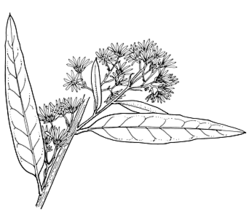Common name: Snowy Daisy-bush
Olearia lirata (Sims) Hutch. APNI* 
Description: Shrub to 4 m high with greyish-white branchlets.
Leaves alternate, petiolate, lanceolate, 30–150 mm long, 5–25 mm wide, usually thinly textured, rugulose. Upper surface green with deeply impressed and obvious venation, glabrous or nearly so; lower surface greyish-white with stellate hairs of varying sizes, with scattered longer hairs; margins mostly entire, sinuate or serrate. No strong foetid smell when crushed.
Flower heads in loose terminal panicles or corymbs, 21–25 mm diam.; peduncles 5–12 mm long; involucre more or less hemispherical, 3.5–4.5 mm long; bracts in 3 or 4 rows, graduating, outer densely pubescent and ciliate towards the apex. Ray florets 10–16, white, 4–8 mm long, disc florets 9–14, cream to yellow.
Achenes flattened obovoid, 6-ribbed, 1.5–2 mm long, sparcely sericeous (silky); pappus bristles, 3.5–4.5 mm long.
Flowering: Flowers August – January
Distribution and occurrence: In moist forest from south coast in NSW to the tablelands. Victoria and Tasmania Subbalpiine.
NSW subdivisions: NT, CC, SC, CT, ST
Other Australian states: Vic. Tas.
Closely related to Olearia phlogopappa. O. lirata has acute leaves. Previously confused with Olearia stellulata which is a species in Victoria and Tasmania. Populations with serrate leaves are found near Penrose in the Central Tablelands.
Text by Louisa Murray
Taxon concept: Walsh, N.G. & Lander N.S. (1999) Flora of Victoria Vol. 4 p 896-897. Messina, A. Walsh, N.G. Hoebee, S.E., Gren, P.T.(2013) A morphological assessment of the Olearia phlogopappa complex (Asteraceae: Asterae) Australian Systematic Botany Vol 26, pp 31-80.
APNI* Provides a link to the Australian Plant Name Index (hosted by the Australian National Botanic Gardens) for comprehensive bibliographic data
***The AVH map option provides a detailed interactive Australia wide distribution map drawn from collections held by all major Australian herbaria participating in the Australian Virtual Herbarium project.
|


